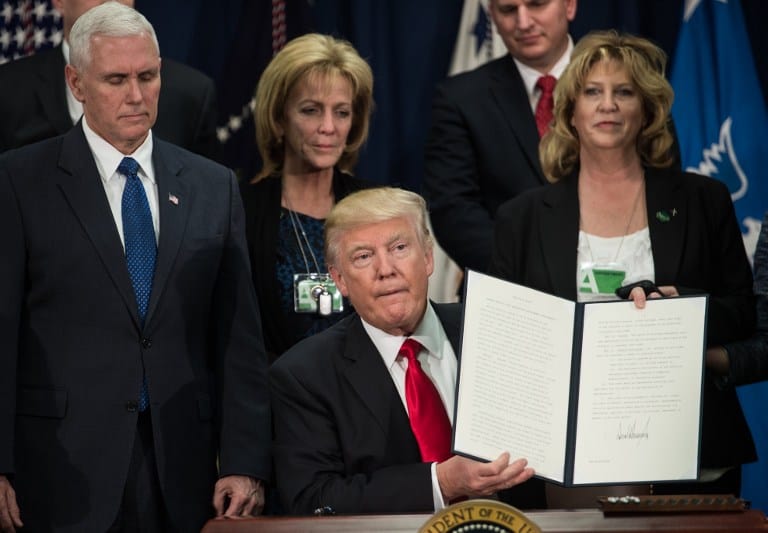While President Donald Trump is scrapping or revising major trade accords, Central America believes a pact it has with the United States will emerge unscathed.
Government officials and business leaders said that the Dominican Republic-Central American Free-Trade Agreement with the United States (CAFTA-DR) is so favorable to the United States that it makes no sense to get rid of it.
However, some apprehension has clouded the prediction, given Trump’s stated penchant for cutting new deals, and preference for bilateral trade accords overal multilateral ones.
“All of us have to be ready to face the consequences in economic or other terms,” Honduran President Juan Orlando Hernandez said.
Trump’s executive order on Tuesday formally withdrawing the United States from the yet-to-be-ratified Trans-Pacific Partnership (TPP), and his pledge to renegotiate the North American Free Trade Agreement (NAFTA) with Mexico and Canada, underline his intent to upend trade arrangements in an attempt to secure greater advantages for his country.
He has made no mention of CAFTA so far. That deal, which Costa Rica ratified in 2007, was the first between the United States and small developing nations.
Watching Trump
According to the Office of the U.S. Trade Representative, $53 billion of trade took place under the pact in 2015, with the U.S. exporting $4 billion more than it imported from Central America.
“It doesn’t cause (the U.S.) any trade distortion and it wouldn’t be a good idea to renegotiate the terms of this accord,” said Sergio Alfaro, Costa Rica’s Presidency Minister. However, he added, his government is “constantly monitoring what is happening in the United States.”
An economic adviser to Nicaragua’s government, Bayardo Arce, also said the region was following Trump’s moves carefully.
“The U.S. president needs to be watched. Nobody knows where he might go with his measures,” he said.
The head of the Union of Producers in Nicaragua, Michael Heally, noted that while NAFTA’s renegotiation was a campaign promise by Trump, there was no mention that CAFTA might be in his sights.
“I don’t believe that CAFTA will be affected,” said Heally, whose association primarily represents farmers.
Yet Alvaro Fiallos, the head of a similar Nicaragua organization, the Union of Farmers and Livestock Producers, admitted there was “uncertainty.”
“We just don’t know what’s going to happen. First we are made to sign CAFTA and then we might need to leave it,” he said.
Migration a bigger issue
Rafael Medina, president of the Chamber of Commerce in Tegucigalpa, Honduras, stressed that the difference between CAFTA and NAFTA “are enormous.”
He said CAFTA was very favorable to the United States, which exports tariff-free, while Central America gained access to a huge market for its manufacturing, which in Honduras generated 135,000 jobs.
A bigger impact on U.S.-Central American relations would instead likely come from Trump’s vows to greatly limit migration and step up deportations, Medina said.
In 2016, Guatemala, Honduras and El Salvador, major sources of undocumented migrants to the United States, received nearly $16 billion in remittances.
That money accounts for between 10 and 17 percent of the gross domestic product of the three countries.
Will there be a wall?
Trump took a first step toward fulfilling his pledge to “build a wall” on the Mexican border Wednesday, signing two immigration-related decrees. Trump visited the Department of Homeland Security to approve an order to begin work to “build a large physical barrier on the southern border,” according to the White House.
Trump also signed measures to “create more detention space for illegal immigrants along the southern border,” according to White House spokesman Sean Spicer.
“We’re going to once again prioritize the prosecution and deportation of illegal immigrants who have also otherwise violated our laws,” he added.
Stemming immigration was a central plank of Trump’s election campaign. His signature policy prescription was to build a wall across the 2,000-mile (3,200-kilometer) border between the United States and Mexico.
Some of the border is already fenced, but Trump says a wall is needed to stop illegal immigrants entering from Latin America.
In 2014, there were an estimated 5.8 million unauthorized Mexican migrants in the United States, according to Pew, with fewer arriving each year before that.
Experts have voiced doubts about whether a wall would actually stem illegal immigration, or if it is worth the billions it is expected to cost, but the policy has become a clarion call for the U.S. right and far-right, the core of Trump’s support.
Still, any action from the White House would be piecemeal, diverting only existing funds toward the project.
The Republican-controlled Congress would need to supply new money if the wall is to be anywhere near completed, and Trump’s party has spent the last decade preaching fiscal prudence.
Furthermore, much of the land needed to build the wall is privately owned, implying lengthy legal proceedings, political blowback, and substantial expropriation payments.
A Morning Consult/Politico poll released Wednesday said 47 percent of voters support building a wall, with 45 percent against.
Trump again promised “100 percent” to make Mexico pay for the wall Wednesday, something the Mexican government has repeatedly said it will not do.
“Ultimately it will come out of what’s happening with Mexico. We’re going to be starting those negotiations relatively soon. And we will be, in a form, reimbursed by Mexico,” he told ABC. “All it is, is we will be reimbursed at a later date from whatever transaction we’ll make from Mexico.”
“I’m just telling you, there will be a payment, it will be in a form, perhaps a complicated form,” the President added. “What I’m doing is good for the United States, it’s also going to be good for Mexico. We want to have a very stable, very solid Mexico”
Trump aides have weighed hiking border tariffs or border transit costs as one way to “make Mexico pay.” Another threat is to finance the wall by tapping into remittances that Mexican migrants send home, which last year amounted to $25 billion.
Mexican Foreign Minister Luis Videgaray and the country’s Minister of the Economy are currently in Washington to prepare a visit by President Enrique Pena Nieto scheduled for January 31.
“There are very clear red lines that must be drawn from the start,” Economy Minister Ildefonso Guajardo told the Televisa network in Mexico just ahead of the trip.
Asked whether his country would walk away from talks if the wall and remittances are an issue, Guajardo said: “Absolutely.”
Trump warned last week that he would abandon NAFTA unless the United States gets “a fair deal.” Mexico has said it is willing to “modernize” the accord, which came into force in 1994 and represents $531 billion in annual trade between Mexico and the United States.
Some 80 percent of Mexico’s exports go to the U.S. market.







